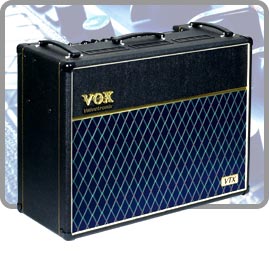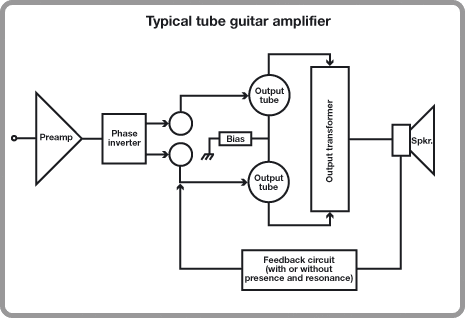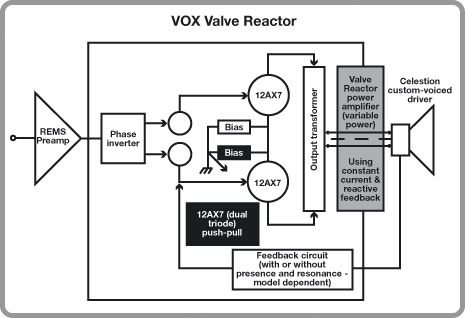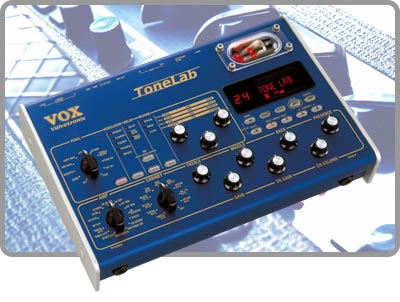The Vox name should be familiar to virtually any guitarist that’s taken that quest for tone or is a regular visitor to this site. That name is of course associated with some of the most famous amplifiers of all time, including the AC15 and AC30. The AC15 had its beginnings in the late 1950’s with the AC30 following soon afterward – and now, even after more than 50 years with the same circuit design at their heart, these are still two amps that continue to be revered for their tone and are as musically useful today as they’ve ever been.
So when Vox announced two years ago that it was moving toward the production of modeling amplifiers, no doubt there was skepticism about what the final product would be like. I’m sure mutterings of “Why mess with a good thing?” were heard and told as well as how a company rooted in “older technology” would do with the creation of amplifiers based on new technology and engineering requirements.
The most well-known and successful Voxes after all, were the full-tube models based on the time-tested original designs. On top of that, there was quite a resurgence of interest in the 90s when the AC30 and AC15 were both reissued, which prompted record levels of sales for those amps. Not exactly a situation that cried out for the need to enter a new marketplace and deliver a modeling amp.
The risks thus far have paid off. Fast-forward to today and Vox has now released its latest generation of successful Valvetronix modeling amplifiers. The Valvetronix AD120VTX is the company’s 120-watt (60w x 2) stereo modeling combo amplifier – and is the most powerful of the two VTX amplifiers (which also includes a smaller 60 watt combo). The AD120VTX is the upgraded replacement for the AD120VT and features a new closed back speaker cabinet design, improved power amp circuitry and two of Celestion’s new “NeoDog” neodymium 12-inch speakers.
Amp Features – The Outside.
From the moment I first unboxed the Valvetronix and examined its high-technology-meets-retro design, I could appreciate the fact that all the necessary features appeared in  place, but at the same time Vox didn’t go overboard with limitless buttons or unnecessary novelties. In other words, I appreciate an amp that does not require its own 200-page book to accompany it all while being touted to be a “Quick Start User Guide!” Not that I’m a minimalist nor advocating that, but I’ve found that there’s a point of diminishing returns when it comes to “tweakability” of certain products and it can go a bit too far. The Vox is nicely balanced here.
place, but at the same time Vox didn’t go overboard with limitless buttons or unnecessary novelties. In other words, I appreciate an amp that does not require its own 200-page book to accompany it all while being touted to be a “Quick Start User Guide!” Not that I’m a minimalist nor advocating that, but I’ve found that there’s a point of diminishing returns when it comes to “tweakability” of certain products and it can go a bit too far. The Vox is nicely balanced here.
Starting from the top panel of controls, quite a range of useful features are included with the Valvetronix family, all cleanly laid out and easy to use. Our test AD120VTX includes 16 amp models that can be adjusted in manual mode with a simple knob twist. Alternately, you can tap into 32 Programs consisting of 8 Banks, each with 4 channels. The specific models are as follows:
1. Black 2 x 12
2. Tweed 1 x 12
3. Tweed 4 x 10
4. AC15
5. AC15TB
6. AC30
7. AC30TB
8. UK Blues
9. UK ‘70’s
10. UK ‘80’s
11. UK ‘90’s
12. UK Modern
13.Recto
14. US High Gain
15. Boutique OD
16. Boutique Clean
 To alter the tone and level of each model, classic chicken-head knobs provide further control for the front panel presence, bass, treble, middle, gain, volume, and master controls.
To alter the tone and level of each model, classic chicken-head knobs provide further control for the front panel presence, bass, treble, middle, gain, volume, and master controls.
The AD120VTX also has all the familiar onboard effects that are operated with push buttons and knobs, again, all in a very analog and easy-to-use fashion. These effects are run “in the chain” after the preamp stage. These include: Chorus, Flanger, Phaser, Tremolo, Rotary, Delay, Tape echo, Multi-head delay, as well as Spring, Plate, and Room Reverb effects.
To round it off, the AD120VTX includes various pedals that are run in front of the signal chain prior to the preamp. The 10 different pedals include Compressor, Acoustic Simulation, VOX Wah, Auto Wah, U-Vibe, Octave Divider, Treble Boost, Tube Overdrive, Fat Overdrive and Fuzz.
Moving to the rear of the unit, a switch and jack for use with external cabinets of various impedances is included. The back panel also has a useful power select switch that is part of Vox’ Variamp circuit that switches the amps available power from its 120 watts all the way down to 1 watt of power.
While all these features collectively make up for a nice-feature set overall, the actual technology inside is what may be of most interest to those players curious about how the amp produces the tones it does to differentiate itself from the rest of the modeling amps out in the marketplace.
Amp Features – The Inside
For years, guitarists have talked about the benefits of tone achieved from the power tube section of amp – many of the greatest amps from the past incidentally just seemed to sound their best when they were turned up. What can one say about the sound of an early tweed Fender Bassman, or a Marshall Plexi Super Lead, or a Vox AC30 turned up – except to say that it’s organic, dynamic, lively and real. It’s the power stage and tube drive that we can thank for much of that great rich tone.
amps from the past incidentally just seemed to sound their best when they were turned up. What can one say about the sound of an early tweed Fender Bassman, or a Marshall Plexi Super Lead, or a Vox AC30 turned up – except to say that it’s organic, dynamic, lively and real. It’s the power stage and tube drive that we can thank for much of that great rich tone.
The guys at Vox were no dummies and obviously had their ears in tune to this philosophy as well when they decided to really focus on the power amplifier section when developing the Valvetronix line. Vox took to the challenge and developed what they call their Valve Reactor power amplifier. An interesting design, the Valvetronix amps use a 12AX7 tube (commonly used as a preamp tube in a tube amp) run at the correct specified plate and heater voltages, then coupled it with an actual output transformer prior to sending the final signal to a solid-state amplifier.
The VariAmp Power Circuit offers control over the amp’s power output and allows decreases from 60 watts to 1 watt and is a critical element to the design. The output transformer is connected the VariAmp Power Circuit which provides what Vox calls Reactive Feedback technology.
For techies interested, this is how Vox describes the design: “The Reactive Feedback technology used in the VariAmp Circuit  ‘reads’ the impedance curve of the speaker and then reports this reactive information back to the secondary side of the output transformer. This information is fed back to the primary side of the output transformer and therefore changes the loading on the tubes, another important part of the vital role an all-tube power amp plays in the creation of traditional tube tone.
‘reads’ the impedance curve of the speaker and then reports this reactive information back to the secondary side of the output transformer. This information is fed back to the primary side of the output transformer and therefore changes the loading on the tubes, another important part of the vital role an all-tube power amp plays in the creation of traditional tube tone.
“Unlike most solid-state amplifiers used in guitar amps which are Constant Voltage designs, the Valvetronix Constant Current design used in the VariAmp allows the output voltage of Valvetronix amplifiers to vary along with the speaker’s changing impedance, just like in a traditional tube amplifier.”
A final note of interest regarding the technology found within the Valvetronix, is a note on the Valve Reactor circuit and its ability to run the power stage of the amplifiers being modeled in appropriate Class A or Class A/B – switching automatically depending on the amplifier model that is selected. While virtually all guitar amplifiers today use Class A/B because it more efficiently uses power, many tube aficionados have a true love for Class A designs (the Vox AC30 and Tweed Fender Champ are two examples of Class A circuits) for the added harmonic character and complexity that comes into play.
The Test Drive
I used both a Fender American Standard Stratocaster and Gibson Les Paul, both loaded with their respective single and humbucking Seymour Duncan Antiquity pickups that were tested and reported on previously. Now it should be said that I could have spent many, many hours playing with each model individually and then trying the “real” amp side by side to determine the “accuracy” of the model. However, there are a number of problems with that test scenario, number one (and most important) being that not all of those vintage original amps will sound exactly the same! Same goes with modern amps and this is due to circuit changes that have been made throughout a life cycle, etc. among other things.
So with that in mind, and being familiar with the majority of the originals, I instead opted to see how each model felt and played, and then thought it would be best to describe how usable the models were in the first place. So in other words, will the AC30 model give the general feel and vibe of an original AC30?
I began with clean tones, beginning with the models based on the clean Fender-like tones and moving through the range of Vox models. The blackface and tweed models were among my favorites that the Valvetronix offered. The tone controls offered a nice range of adjustment and I was able to dial in some very warm bluesy tones. When moving a bit into the territory of breakup and mild overdrive, the models had a good feel and sense of dynamics.
Judging the Valvetronix against the previous Line6 modeling amps I’ve played (Flextone, Flextone II, and Vetta) on the merits of warm clean and bluesy sounds made for literally an “apples to oranges” comparison. The Valvetronix is so clearly superior at producing these tones that players seeking bluesy sounds in a modeling amp will no doubt be pleased.
In this environment as well, the Les Paul stayed true to its character with its usual wide mid-range and strong upper low-end tone. The Stratocaster had its usual sparkle on the top end and glassy bottom.
Moving on to the AC15 and AC30 models, I was equally impressed with the performance of the Valvetronix. Because of the complex harmonic characteristics of Vox AC15’s and 30’s, they are no doubt amongst the most difficult amps to model. Moving through the range of gain and tone between each Vox model, they all demonstrated the range of chime and semi-overdriven tones that one would anticipate to hear. I also enjoyed running the treble-boost pedal model in front of the Vox models and got a mix of a fatter midrangy-tone with a crisp top end that retained its smoothness.
As was the case with the Fender models, bass response for the Vox models was ample when desired. No doubt this was due in part to the Celestion “NeoDog” speakers housed in the closed-back cabinet. This configuration takes some getting used to as most combos are open back and therefore have a wider dispersion of tones emanating from the backside. The Valvetronix is much more “focused” as a result and I actually preferred this overall the more I played with it.
The range of distorted models was interesting and fun to play through. As an admitted Marshall-emphasized tone-freak, I’d have to say that from all the various models on board, those of the Marshall type as well as the high-gain varieties were probably the least “accurate” with the Valvetronix. However, the good news is that they are ALL very useable tones regardless. I’ll be the first to admit that there are plenty of bunk-sounding Marshalls and high-gain amps out there of all varieties – both new and vintage. So at least it’s not a model of a bad Marshall in here – What’s inside are good rock and high-gain metal tones. The plexi model Marshall was in fact reminiscent of the fluid Eric Johnson type of tones, but did on the other hand lack much of the crunch characteristic of tones you’d hear from bands like AC/DC (both tones of which I enjoy greatly).
In fact, I thought of the various British and American-influenced distorted tones as being somewhat all similar in character and smoothness, but with different ranges of equalization points as well as gain structure. So if one were to want a direct “Marshall JCM 800” and then jump to a “Mesa Boogie Rectifier”, they’d probably be disappointed because the models don’t sound as dramatically different as the amps do in real life.
However, with that said, the sounds that I achieved when wanting a good standout rhythm at lower-gain or lead tone at high-gain, were all there and quite enjoyable to use. It’s obvious that great care went into listening to the final results of the tones in the Valvetronix – whether I ran higher gain with the Strat or the Les Paul, I was able to obtain a range of good tones. The Marshall plexi model really reminded me of the characteristically fluid Eric Johnson type of tone rather than the crunchy AC/DC-type sounds.
After all the experimentation with the Valvetronix in my home studio with good results overall, the ultimate final listening test for me was to then take it to band rehearsal and use it at higher volume against other instruments.
As I began to play with an overly-loud drummer that hits his set hard – VERY hard – rivaling Zep’s John Bonham – and using the loudest stage crashes available on the market to boot, the Valvetronix to my surprise not only provided enough volume, but retained its warm tonal characteristics that I had experienced at home! The distortion channels sounded smooth and the amp felt right – it really does react to one’s playing without the sterility one would expect after perhaps having some bad experiences with other modelers used at high volume.
All was not perfect at high-volume however – the amount of bass response overall is tremendous. As a result, when playing at higher levels I had to turn the bass down completely on a few of the models and probably still had a little bit more than I wanted. There were also a couple of instances where I wish I could have dialed up a bit more midrange or top end, but for the most part, the equalization is very finely tunable. The output transformer and tube section no doubt play a big role as well in achieving the great tones and feel I achieved from the Valvetronix.
I took the opportunity in the band-environment to run through all of the built in effects that run “in front” of the amplifier section, as well as the modulation effects that occur after the preamp. Contrary to what I expected, the onboard effects simply sounded stunning. While they may be limited in the amount of tweaking options, I’d much prefer that tradeoff and have a simplified effects section that sounds exceptional instead of mediocre effects with more buttons.
On the front end, I found the overdrive and boost pedal models exceptionally strong. The acoustic simulator was perhaps my least favorite of the front-end effects, but then again no acoustic simulator has really sounded convincing to my ears, regardless of how pleasant they may sound.
Moving over to the modulation effects, the Valvetronix has an especially impressive chorus and reverb. The digital delay was also excellent, though the tape echo effect model should likely be relabeled as an analog delay model. Its sound was more akin to the classic Bucket Brigade Device analog delay tones in how the repeats decayed. This is not a bad thing – but it’s not tape delay.
Overall, the Valvetronix VTX is a perfect mix of capable and useful amplifier models with onboard effects and power options that are intuitive and well laid out. For the gigging guitarist that is interested in using a wide palette of tonal colors, the Valvetronix VTX is highly recommend and is quite simply the finest amplifier I’ve played in its class.
Now with that said, will it replace my fine, though modest collection of vintage Marshall, Vox, Hiwatt, and Fender amplifiers? Absolutely not, BUT if I needed to play a gig and wanted to have a wide range of tonal colors to choose from, the Valvetronix would be the first pick and do more than just an adequate job – in fact, its tones would bring a smile to my face – just like my old classics do everytime I play them. Kudos to team Vox – the Valvetronix VTX is a fine amplifier.
Vox Tonelab – The power of Valvetronix – but specialized for direct recording
Vox recently unveiled its Tonelab direct recording device and in doing so is competing head to head with a veritable range of  other direct-recording modeling devices. Vox positions the Tonelab at the upper end of the modeling echelon however, and includes its Valve Reactor circuit with its glowing tube that further differentiates it from the competition.
other direct-recording modeling devices. Vox positions the Tonelab at the upper end of the modeling echelon however, and includes its Valve Reactor circuit with its glowing tube that further differentiates it from the competition.
The basic features of the Tonelab are identical to the Valvetronix range of amplifiers, but the Tonelab actually incorporates a bit more. There are 16 amp models just like the amps, but the Tone Lab also includes 11 cabinet model types in addition to 50 effects and 96 programs. MIDI in and out jacks are also part of the package as are a user interface that allows for editing programs via software that can be downloaded from www.voxamps.co.uk.
When going through the range of tones in the Tonelab through a set of headphones, I found that dialing in good tones was very easy and didn’t require hours of work. Unlike the Pod XT we previously reviewed, the Tonelab is much more straight forward – I like that.
The tones were generally much smoother as well with the Tonelab. The POD XT could be a bit “spiky” in its tone and some patches are just plain sterile. The Tonelab doesn’t suffer through these deficiencies and like it’s bigger brother Valvetronix VTX, does an exemplary job at emulating blues-and-classic rock style tones.
Because the Tonelab has cabinet modeling available, it’s a bit easier to get a wider range of high-gain sounds too. The Tonelab definitely does a nice job capturing high-gain tones that sounded nice when test recording them into my computer running Sonic Foundry Software.
An advantage of this type of recording instead of using an amp and microphone is that the Tonelab definitely gives you the tone you’re already hearing through the headphones. It’s “what you hear is what you get”. With an amp/microphone setup, there are additional coloration and phase characteristics that have to be taken into account. Sometimes those characteristics can work in your favor, other times…well, we’ll just say that they might not.
At an SRP of $600 and current street pricing of $450.00, the Tonelab isn’t considered necessarily “cheap” when compared to some other modelers available. However, if you’re a stickler for tone and looking for a great addition to your digital recording studio setup, the Tonelab will certainly do the job quite nicely.